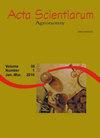Effect of light spectra on stem cutting rooting and lavender growth
IF 1.2
4区 农林科学
Q3 AGRONOMY
引用次数: 0
Abstract
French lavender (Lavandula dentata L.) is of great ornamental, medicinal, and aromatic interest. It is generally propagated vegetatively using stem cuttings. When using artificial lighting, a specific light composition can modify the entire plant phenology and is a factor that can be managed in controlled conditions. This study evaluated the rooting of stem cuttings and growth of lavender under four spectral LED lights. The LED lights used were: T0 (white LED, Roblan®), T1 (AP67 Milky, Valoya®), T2 (NS1, Valoya®), and T3 (AP673L Milky, Valoya®). The first phase evaluated the rooting of stem cuttings and initial development. The plants were then transferred to plastic pots to evaluate plant growth. In both rooting and growing phases, the plant morphological characteristics and water and light efficiencies were evaluated. Nutrient-uptake efficiencies were also evaluated after the growing phase. It was observed that cuttings rooted under the influence of T1 showed greater height. After the growing phase, plants under T3 showed better results in electricity use efficiency, water use efficiency, and nutrient-uptake efficiency and less nitrate leaching. They also presented more uniform growth with a compact canopy. Thus, T1 was better for the stem cuttings rooting phase, while T3 was better for growth and energy efficiency.光谱对薰衣草茎切、生根及生长的影响
法国薰衣草(Lavandula dentata L.)具有很高的观赏、药用和芳香性。它一般是无性繁殖利用茎插枝。当使用人工照明时,特定的光组成可以改变整个植物物候,这是一个可以在可控条件下进行管理的因素。研究了四种光谱LED灯对薰衣草茎插条生根和生长的影响。使用的LED灯有:T0(白色LED, Roblan®),T1 (AP67 Milky, Valoya®),T2 (NS1, Valoya®),T3 (AP673L Milky, Valoya®)。第一阶段评价茎插枝的生根和初期发育。然后将这些植物转移到塑料花盆中,以评估它们的生长情况。在生根和生长两个阶段,对植株形态特征和水分光效进行了评价。在生育期结束后,还评估了养分吸收效率。结果表明,在T1影响下生根的扦插苗具有较高的扦插高度。生长期结束后,T3处理的植株在电利用效率、水分利用效率和养分吸收效率方面表现出较好的效果,硝态氮淋失较少。它们也表现出更均匀的生长和紧凑的冠层。因此,茎插条生根期T1较好,生长和能量利用期T3较好。
本文章由计算机程序翻译,如有差异,请以英文原文为准。
求助全文
约1分钟内获得全文
求助全文
来源期刊

Acta Scientiarum. Agronomy.
Agricultural and Biological Sciences-Agronomy and Crop Science
CiteScore
2.40
自引率
0.00%
发文量
45
审稿时长
>12 weeks
期刊介绍:
The journal publishes original articles in all areas of Agronomy, including soil sciences, agricultural entomology, soil fertility and manuring, soil physics, physiology of cultivated plants, phytopathology, phyto-health, phytotechny, genesis, morphology and soil classification, management and conservation of soil, integrated management of plant pests, vegetal improvement, agricultural microbiology, agricultural parasitology, production and processing of seeds.
 求助内容:
求助内容: 应助结果提醒方式:
应助结果提醒方式:


